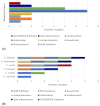Cachrys L. Genus: A Comprehensive Review on Botany, Phytochemistry and Biological Properties
- PMID: 36771650
- PMCID: PMC9921173
- DOI: 10.3390/plants12030565
Cachrys L. Genus: A Comprehensive Review on Botany, Phytochemistry and Biological Properties
Abstract
The Cachrys L. genus belongs to the Apiaceae family and it is widely distributed in the Mediterranean basin, with plant species being endemic to southern Europe, Asia, and northern Africa. Different studies, focused on the phytochemical composition of Cachrys spp. and the biological properties of their phytocomplexes, have been reported. These works mostly focused on the essential oils obtained from these plants, and pointed out that Cachrys species are a rich source of coumarins, mainly furanocoumarins. Other phytochemicals, such as terpenes, fatty acids, phytosterols, and flavonoids have been also identified. Moreover, a number of biological properties such as antioxidant, antimicrobial, anti-inflammatory, cytotoxic, and photocytotoxic effects have been assessed. Nevertheless, a review of the chemical and pharmacological properties of this genus is not available in the literature. The aim of this paper is to provide an overview of the reports concerning the identified phytochemicals and the biological effects reported for Cachrys spp., and to offer a comprehensive understanding of the potential of this genus as a source of bioactive compounds. The current taxonomy, the traditional uses, and the toxicological aspects of plants belonging to this genus are also reported, and the future research directions are discussed.
Keywords: Apiaceae; Cachrys; bioactive compounds; coumarins; essential oils; ethnobotany; photocytotoxicity; phytochemicals.
Conflict of interest statement
The authors declare no conflict of interest.
Figures




Similar articles
-
The ethnobotany, phytochemistry and biological properties of genus Ferulago - A review.J Ethnopharmacol. 2021 Jun 28;274:114050. doi: 10.1016/j.jep.2021.114050. Epub 2021 Mar 20. J Ethnopharmacol. 2021. PMID: 33753144 Review.
-
The phytochemistry and biological diversity of Ferulago genus (Apiaceae): a systematic review.J Pharm Pharmacol. 2021 Mar 1;73(1):1-21. doi: 10.1093/jpp/rgaa034. J Pharm Pharmacol. 2021. PMID: 33791809
-
Genus Paeonia: A comprehensive review on traditional uses, phytochemistry, pharmacological activities, clinical application, and toxicology.J Ethnopharmacol. 2021 Apr 6;269:113708. doi: 10.1016/j.jep.2020.113708. Epub 2020 Dec 24. J Ethnopharmacol. 2021. PMID: 33346027 Review.
-
Traditional uses, phytochemistry and pharmacological properties of the genus Peucedanum: a review.J Ethnopharmacol. 2014 Oct 28;156:235-70. doi: 10.1016/j.jep.2014.08.034. Epub 2014 Sep 3. J Ethnopharmacol. 2014. PMID: 25193684 Review.
-
The genus Daphne: A review of its traditional uses, phytochemistry and pharmacology.Fitoterapia. 2020 Jun;143:104540. doi: 10.1016/j.fitote.2020.104540. Epub 2020 Mar 10. Fitoterapia. 2020. PMID: 32165275 Review.
Cited by
-
The Antioxidant Properties and Protective Capacity of Prangos trifida and Cachrys cristata Essential Oils against Cd Stress in Lunularia cruciata and Brassica napus.Antioxidants (Basel). 2023 Mar 24;12(4):793. doi: 10.3390/antiox12040793. Antioxidants (Basel). 2023. PMID: 37107168 Free PMC article.
-
Pharmaco-Toxicological Effects of Cachrys libanotis Extract: Antioxidant, Antimicrobial, and Cytotoxic Activities in Human Cell Lines and Embryonic Models.Antioxidants (Basel). 2025 Jun 30;14(7):810. doi: 10.3390/antiox14070810. Antioxidants (Basel). 2025. PMID: 40722914 Free PMC article.
-
Phytochemical Profile and In Vitro Antioxidant and Photobiological Properties of Different Extracts from Prangos ferulacea Lindl.Antioxidants (Basel). 2023 Feb 5;12(2):384. doi: 10.3390/antiox12020384. Antioxidants (Basel). 2023. PMID: 36829943 Free PMC article.
References
-
- The International Plant Names Index. 2022. [(accessed on 2 February 2022)]. Available online: http://www.ipni.org.
-
- Ferrer-Gallego P.P., Fabado J. (2822) Proposal to Conserve the Name Cachrys libanotis (Umbelliferae) with a Conserved Type. TAXON. 2021;70:682–684. doi: 10.1002/tax.12519. - DOI
-
- WFO. 2022. [(accessed on 28 November 2022)]. Available online: http://www.worldfloraonline.org.
-
- Grande M., Aguado M.T., Mancheño B., Piera F. Coumarins and Ferulol Esters from Cachrys sicula. Phytochemistry. 1986;25:505–507. doi: 10.1016/S0031-9422(00)85511-9. - DOI
-
- Marrelli M., Perri M.R., Amodeo V., Giordano F., Statti G.A., Panno M.L., Conforti F. Assessment of Photo-Induced Cytotoxic Activity of Cachrys sicula and Cachrys libanotis Enriched-Coumarin Extracts against Human Melanoma Cells. Plants. 2021;10:123. doi: 10.3390/plants10010123. - DOI - PMC - PubMed
Publication types
LinkOut - more resources
Full Text Sources
Miscellaneous

